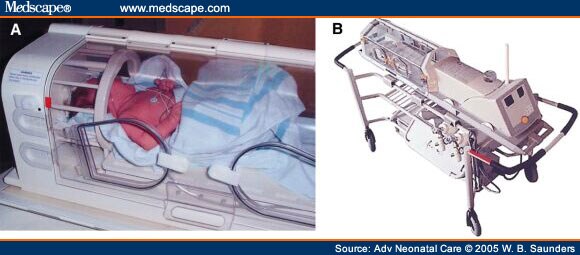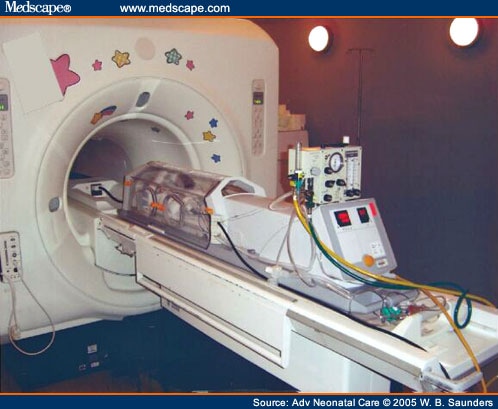The MR-Compatible Incubator
Magnetic resonance imaging would be a valuable diagnostic tool for many of the smaller, sicker infants cared for in the NICU, but the difficulties of providing a safe imaging environment for these infants often preclude its use.[24] Dedicated scanners located within the NICU might offer a higher level of safety for MR imaging of unstable infants; however, these are rare.[24,44]
MR-compatible incubators have recently been developed, permitting the complex and challenging task of obtaining neonatal MRI to be accomplished in a controlled microenvironment with monitoring equal to that of the NICU.[44,45,46,47,48] One such incubator, custom-built to provide thermal support, complete physiologic monitoring, and blended air and oxygen in a battery-powered unit, has been successfully used to safely image infants <1 kg.[46] This unique system incorporates a camera that transmits continuous video of the infant to an external monitor throughout the scanning procedure.[45]
A commercially available MR-compatible incubator (Neonate Imaging Sub-System, Advanced Research Imaging, Inc, Cleveland, Ohio) has built-in RF head coils optimized for neonatal brain volume[47] (Fig 4A, 4B). The double-wall incubator is temperature and humidity controlled and attenuates acoustic noise during scanning by 10 to 20 dB (A). The battery-powered trolley can keep the incubator functioning up to 3 hours on a single charge, and it can be plugged into a 110V AC outlet (Fig 4B). Ports on each side and a sliding patient table allow access to the infant, if necessary, without compromising the microenvironment of the incubator. Nonmagnetic air and oxygen tanks are integrated so that the infant can receive oxygen via a nasal cannula or ventilator. MR-compatible monitors, infusion pumps, and a ventilator can be mounted on the incubator to create a fully mobile NICU transport incubator.
(A). Neonatal MR-compatible incubator with controlled temperature and humidity, and built-in radiofrequency head coil. Body coils are also available. From Bluml S, Friedlich P, Erberlich S, Woods JC, Seri I, et al. MR imaging of newborns by using an MR-compatible incubator with integrated radiofrequency coils: initial experience. Radiology . 2004;231:594-601. Reprinted with permission of the Radiological Society of North America. (B) Neonatal MR-compatible incubator on wheeled trolley for transporting infant within the hospital. Image used with permission of Ravi Srinivasan, PhD, Advanced Imaging Research, Inc, Cleveland, Ohio, www.advimg.com .
A significant advantage of the MR-compatible incubator is that once the infant is placed in the incubator in the NICU, the infant remains in a stable environment during transit to and from the radiology department and throughout the MR procedure. Upon arrival at the MRI suite, it is not necessary to retransfer the infant to the MR scanning table because the MR incubator docks directly into the bore of the magnet (Fig 5). The infant is not subjected to the cool air of the MR room or exposed to potential projectile objects.
Neonatal MR-compatible incubator docks directly into the bore of the magnet. Image used with permission of Ravi Srinivasan, PhD, Advanced Imaging Research, Inc, Cleveland, Ohio, www.advimg.com.
The MR-compatible incubator appears to offer a number of safety advantages over current practices for obtaining MR studies in the infant, although the technology is quite new and experience is limited to a few centers. Anecdotal reports suggest that the use of the MR-compatible incubator controls environmental stimuli and enhances comfort; therefore, less sedation may be necessary. In many instances, the testing was completed with no sedation or anesthesia at all.[42] The quality of imaging studies obtained using MR-compatible neonatal incubators is reported to be good to excellent.[44,48]
Visualization of the infant within the incubator is not possible from the control room; to ensure safety, a neonatal staff member must remain in the scan room at all times.[44] Alternatively, an MR-compatible camera with a remote monitor can be added to the system to enable continuous, close-up surveillance of the infant throughout the scanning procedure.
There is a theoretical risk of overheating infants when using an external heat source (e.g., an incubator) combined with the effect of RF energy deposition during MRI.[48] This effect was monitored in a recent study that did not observe substantial increases in skin temperatures of infants within the MR-compatible incubator when RF power was applied.[48] The thermoregulatory requirements of infants during MRI is poorly understood and further study is needed to enhance clinical care.
Adv Neonatal Care. 2005;5(1):14-27. © 2005 W.B. Saunders
Cite this: Ensuring Safety for Infants Undergoing Magnetic Resonance Imaging - Medscape - Feb 01, 2005.







Comments